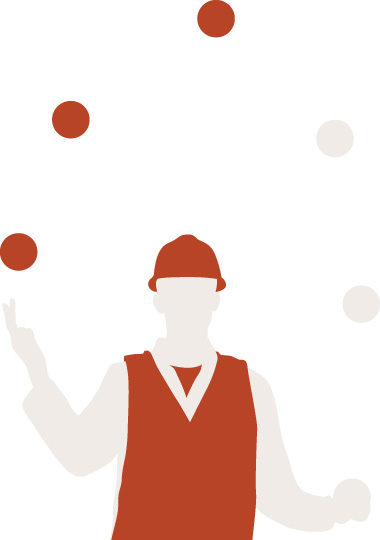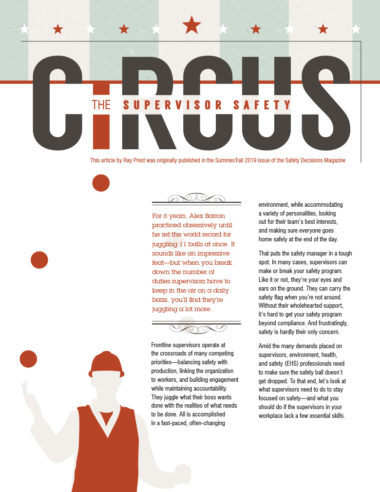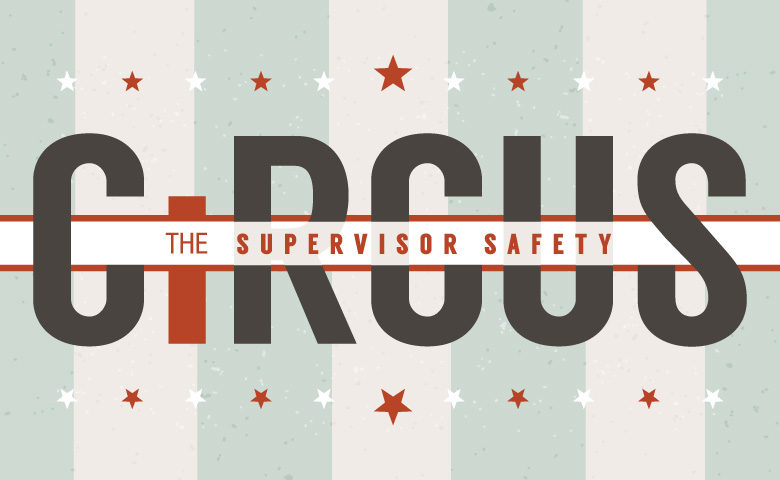This article by Ray Prest was originally published in the
Summer/Fall 2019 issue of the Safety Decisions Magazine.
For 6 years, Alex Barron practiced obsessively until he set the world record for juggling 11 balls at once. It sounds like an impressive feat—but when you break down the number of duties supervisors have to keep in the air on a daily basis, you’ll find they’re juggling a lot more.
 Frontline supervisors operate at the crossroads of many competing priorities—balancing safety with production, linking the organization to workers, and building engagement while maintaining accountability. They juggle what their boss wants done with the realities of what needs to be done. All is accomplished in a fast-paced, often-changing environment, while accommodating a variety of personalities, looking out for their team’s best interests, and making sure everyone goes home safely at the end of the day.
Frontline supervisors operate at the crossroads of many competing priorities—balancing safety with production, linking the organization to workers, and building engagement while maintaining accountability. They juggle what their boss wants done with the realities of what needs to be done. All is accomplished in a fast-paced, often-changing environment, while accommodating a variety of personalities, looking out for their team’s best interests, and making sure everyone goes home safely at the end of the day.
That puts the safety manager in a tough spot. In many cases, supervisors can make or break your safety program. Like it or not, they’re your eyes and ears on the ground. They can carry the safety flag when you’re not around. Without their wholehearted support, it’s hard to get your safety program beyond compliance. And frustratingly, safety is hardly their only concern.
Amid the many demands placed on supervisors, environment, health, and safety (EHS) professionals need to make sure the safety ball doesn’t get dropped. To that end, let’s look at what supervisors need to do to stay focused on safety—and what you should do if the supervisors in your workplace lack a few essential skills.
Extensive Skills
Supervisors need a dizzying array of skills in their toolbox to complete their job successfully, from the ability to remember layers of compliance and operational requirements to the intricacies of communicating up, down, and across the organization. Reporting, scheduling, task setting, skill coaching, problem solving, relationship building, culture building, climate setting— the list of core competencies could literally fill the rest of this article.
Take employee-organization communications as one example of the impact of supervisory skills. In most organizations, there’s a downward communication breakdown where as little as 20% of top-level messages reach frontline workers. One of the biggest determinants of how much of that message trickles down to employees is a supervisor’s ability to communicate.
If you want to avoid this broken telephone effect, your supervisors need to translate organizational vision and abstract objectives into the specific work that needs to be done. They will also have to do it in a motivational way that creates meaning and purpose for each individual. And doing that requires authenticity and leadership skills that inspire employees to take action.
Focus on the Future
 Supervisors could really use a crystal ball sometimes. They must foresee issues before they happen—to prevent an injury, avoid a costly mistake, or predict a sudden change in the number of physical materials required for the job.
Supervisors could really use a crystal ball sometimes. They must foresee issues before they happen—to prevent an injury, avoid a costly mistake, or predict a sudden change in the number of physical materials required for the job.
This is tough enough for the tangibles, the things you can see, touch, measure, report on, or ask people to do. But for every tangible, there are many intangible concerns that need to be anticipated, like the need to build trust or to know which words will influence actions.
If supervisors don’t understand how systems and human factors affect behavior, how will they be able to reliably predict safety compliance in a fluctuating environment? Unless all of your supervisors graduated from college with degrees in psychology, this is something they’ll need to learn and practice.
Safety will never dominate the conversation on the shop floor.
Competing Priorities
The EHS Daily Advisor runs an annual survey of safety professionals, and every year respondents say they want supervisors to better participate in safety. But the safety department isn’t alone in wanting more from supervisors. Operations, customer service, and HR departments also expect frontline supervisors to support new initiatives and requirements—while constantly reporting on a heady list of production key performance indicators (KPIs).
A recent study in the Journal of Safety Research categorized the type and frequency of communications supervisors have with workers. It highlights how many conversations they have—and how few of them are safety-related discussions (2.9%), compared to relationshiprelated (10.2%), and productionrelated (58.7%) conversations.
The message here is clear—safety will never dominate the conversation on the shop floor. This means you need to train supervisors on how to wedge safety issues into discussions about production and other priorities.
Safety Responsibilities
It’s about time—we’re over halfway through this article, and we’ve finally hit the section on safety. Obviously, supervisors need a robust understanding of safety, and most readers of this article would argue that this section should have come first. Safety should always come first, but we know that’s rarely the case in practice.
If you could teach people a rule or procedure once and they’d comply every time thereafter, then safety communication wouldn’t be a problem. But safety failures are almost always a result of human factors—people forget, get distracted, or become overconfident, or human-designed systems fail.
Fortunately, supervisors are in an ideal position to remind people about safety concerns, to help workers build the habits of complying with safety rules, and to coach them on looking out for themselves and each other.
But asking supervisors to do all that is a pretty tall order. They need to understand how people get hurt and why they take shortcuts, and they also must know how to communicate with their subordinates in an engaging and sustainable way.
Training Better Jugglers
 It’s clear that supervisors need a lot of skills, some of which are pretty complex. This means they need plenty of coaching and training. And as we’ve just seen, time is always a challenge. Production doesn’t stop for supervisors to sit in a classroom. Training budgets are perpetually tight. The last thing supervisors want is to juggle training in addition to all the other balls in the air.
It’s clear that supervisors need a lot of skills, some of which are pretty complex. This means they need plenty of coaching and training. And as we’ve just seen, time is always a challenge. Production doesn’t stop for supervisors to sit in a classroom. Training budgets are perpetually tight. The last thing supervisors want is to juggle training in addition to all the other balls in the air.
So, what are safety professionals to do if their frontline supervisors aren’t up to the task? Start juggling.
We’ve just reviewed how crucial it is for supervisors to be strong communicators, build strong relationships with their team, and have a deep understanding of human factors. If they don’t have those skills, you need to find a way to help them develop them.
Any old search engine will tell you there are plenty of training options out there, but surprisingly few of them cover both safety and communication skills so you may need to consider multiple programs. Online-only courses are cheap and easy for providing information, but they can’t really provide individualized coaching or hands-on skill development. You do get what you pay for.
If budget is an issue, try getting support from other departments since soft skills like communication are transferable and will provide a boost to every functional area that makes demands of supervisors. If time is an issue, look for supervisory training that provides real-time coaching. (The big benefit here is that it doesn’t pull supervisors away from their job.)
In both cases, squeeze in microlearning opportunities whenever possible to extend and sustain the learning. Occasionally, your organization may need to bite the bullet and put supervisors through full leadership training, but this could be handled individually based on specialized assessments.
You don’t need your supervisors to break any world records to get the job done. But developing their communication skills and situational awareness will certainly help your safety record. Be sympathetic for the frontline chaos they wrangle and try to be the ringmaster who coordinates the support they need.
Ray Prest is the Director of Marketing at SafeStart, a safety company focused on human factors solutions that reduce preventable death and injuries on and off the job. A columnist for Safety Decisions since 2015, Ray’s been helping people learn about safety and training for over 20 years. Read more at safestart.com/ray.

Get the PDF version
You can download a printable PDF of the article using the button below.

